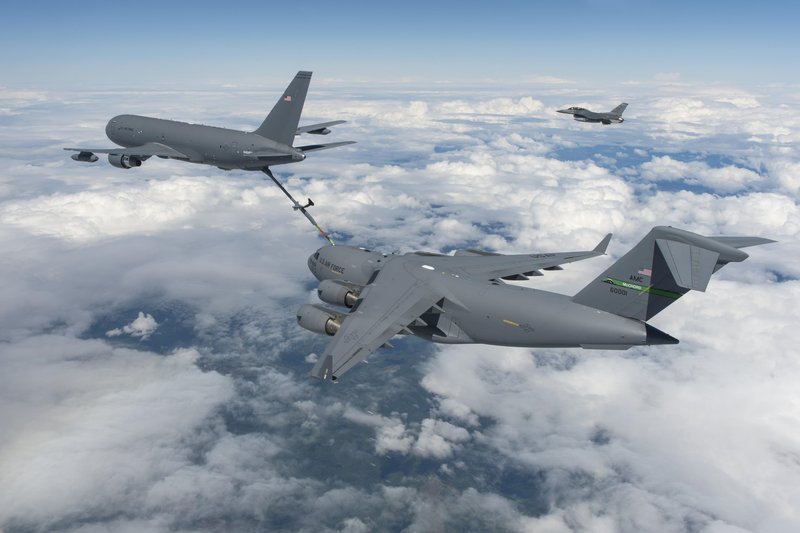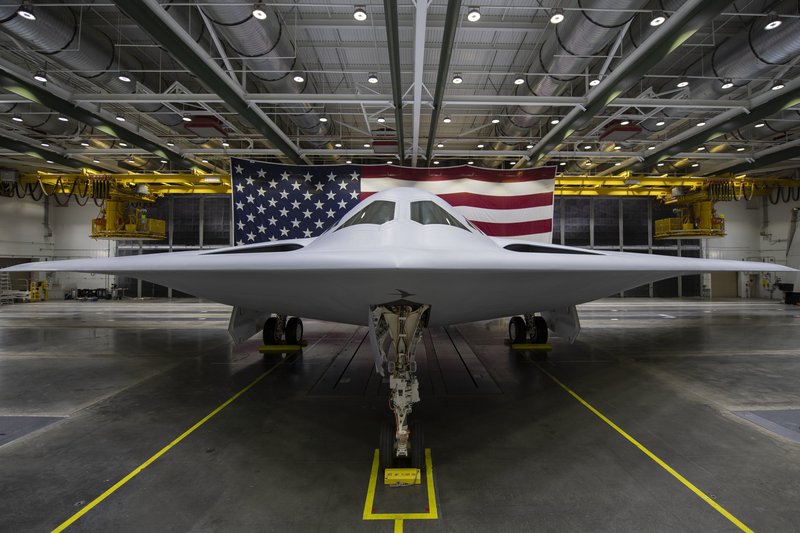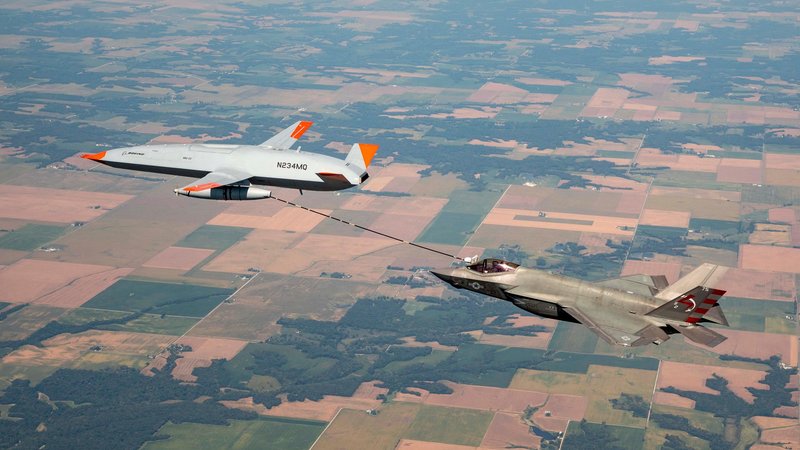Rethinking support fleets – does the US need to change direction on tankers and transports?
With the Middle East now joining Ukraine as a testing ground for new weapons and tactics, attention has understandably focussed on the direct confrontation between combat platforms across an increasingly varied and evolving battlefield.
With both theatres involving relatively short distances compared to a putative Pacific conflict, support and supply have been of less interest... Continues below
Newsletter Sponsor:

Above: The vulnerability of support aircraft to modern air defences plus the operational distances that must be covered in the Pacific may lead to a rethink of US tanker and transport plans. (Photo: USAF)
But programmes for tankers and transports – fixed and rotary – continue in the background, and the high operational tempo and consumption of ammunition and spares has only emphasised the need for rapid and efficient logistics.
Meanwhile, recent Houthi and Iranian drone strikes have been countered by fuel-thirsty air defence fighters that need tanker support if they are to maximise their persistence rather than regularly return to base.
Just as attack helicopters have fallen out of US favour, the tanker-transport has seen several re-examinations in the face of autonomous aircraft and growing threats to traditional support platforms.
The planned US pivot to the Pacific has become something of a stuck record, with every year bringing yet another commitment to reorient mass and capability towards the perceived behemoth of Chinese strategic ambitions.
But this issue does carry a need to settle the future aerial refuelling tanker and airlift questions, given the distance and paucity of basing opportunities in the Pacific, not to mention such assets’ vulnerability to interception or strikes.
Despite the surprise cancelation of the attack/reconnaissance leg of Future Vertical Lift, the US Army in its selection of the V-280 tiltrotor has clearly decided that range and speed are priorities for its next generation of transports.

Meanwhile the USN also decided that a hybrid aircraft – the V-22 – should play the role of tactical transport for shipboard resupply. Although the CMV-22B is an extended-range model, its selection was met with scepticism owing to concerns over its speed vs range vs carrying capability.
Nevertheless, it does offer a flexible support platform for both naval vessels and shore-based forces, including the USMC.
More interesting, in terms of future capability, is the place of the uncrewed MQ-25. A low-RCS design, its evolution from putative strike to actual refueller has been discussed on many occasions.
What it does provide is forward tanking for naval aircraft and extension of operational range for fast jets coming in and out of hostile airspace. Aerial refuellers, more than transports, are very much high value assets and their loss represents a significant disruption to operations. A stealthy high-speed aircraft with better survivability on the outskirts of enemy territory is a welcome addition to the mix.
The USAF remains open to a decision on a new support fleet. Though the C-5, C-17 and C-130 will soldier on for a considerable time yet, the issue of survivability in contested airspace renders them unsuitable for a modern equivalent of the Vietnam War’s famous ‘Khe Sanh approach’.
In the face of 21st century integrated air defences, it is likely that no amount of skilled airmanship will spare these platforms. The alternative approach is unclear, although nominally the USAF is considering a variety of options (a classic ‘system of systems’) including airships, disposable gliders and one-way uncrewed aircraft.
Most of these will likely be rejected as unsound on a cost or capability basis, and despite the understandable goal of avoiding the one-size-fits-all approach there will likely be a coalescence around a standard and relatively conservative design.
As an example, the interest in large airships for resupplying dispersed units is unsurprising, but they are vulnerable and represent a single point of failure. Various studies have shown that they are less efficient than a fleet of conventional cargo aircraft operating as a relay team.
While the discussion around replacing the C-5 and its smaller brethren remains inconclusive, the USAF tanker debate continues to generate significant interest.
The KC-46, as frequently noted, has joined a series of Boeing programmes of concern. But its continued procurement and service – albeit at a staggering cost to the company – simply cannot be avoided.

Above: While various renderings of clean-sheet stealth designs have been released by companies making pitches for KC-Z, one solution might be the creation of a tanker version of the B-21. (Photo: USAF)
As the KC-X (initial new tanker for KC-135 replacement), it was anticipated to be joined by the KC-Y (likely another converted airliner, and now apparently defunct) followed by the KC-Z, the latter being a bespoke design for the ‘tip of the spear’ role.
To support a major combat operation over the South China Sea would require multiple tankers in a tightly coordinated ballet and some of these will need to advance close to the dreaded A2/AD zone. KC-Z was supposed to allow this, but it remains unclear as to whether such a platform is realistic.
The major US aerospace primes have all proffered low-RCS KC-Z designs. Indeed, only this week, and after the initial draft of this article was written, Lockheed Martin published a new image of a quasi-flying wing tanker.
This and its equivalents would undoubtedly be extremely complex and expensive, which may partially explain the air force’s reluctance to commit. They also do not overcome the inherent risk of a very high value asset: loss of a ‘stealth tanker’ would be an order of magnitude more serious than a KC-46.
The last five years have shown just how lethal contested airspace can be and even pessimistic planning for losses may prove insufficiently sanguine. Meanwhile the KC-46 is a sufficient solution to long-range tanking and, crucially, available in numbers.
The current USAF C-series transports fulfil their role and – except for a potential special forces aircraft – any replacement would almost certainly be of similar design.
But could a stretched air force budget swallow a new, small fleet of high-cost refuelling aircraft with stealthy characteristics?
At a more tactical level, the need for next-generation survivable support aircraft is widely accepted. From a sheer opportunity cost perspective, the army’s V-280 and navy’s CMV-22 selection are entirely defendable. Extrapolating tiltrotor technologies into a relatively low-risk multirole transport – of C-130 size – is entirely possible. But none of this addresses the Pacific theatre refuelling issue.
Forces tend to champion their own solutions and platforms. The USAF is no exception, and supported strongly by industry. But to keep fleet mass high and costs low, future refuelling might just be addressed by simply making best use of current designs and developments.
The KC-46 is here to stay and hence arguably best augmented with companion assets. Much has been made of the ‘loyal wingman’, a concept that remains poorly defined from a cost vs capability perspective.
So could a simplified MQ-25 equivalent operating as a ‘loyal tanker’ prove to be a better KC-Z solution? Fairly autonomous, or at least managed in groups, and using larger KC-46s as mobile filling stations, a fleet of small, uncrewed and mutually supporting aircraft might be the lowest risk and highest redundancy option for front-line refuelling.

Above: A ’loyal tanker’ based on the MQ-25 or similar would have better survivability in a contested environment than a KC-46, and would be easier to replace. (Photo: USN)
To use a historical analogy, the continuous ’taxi rank’ presence of ground-attack aircraft over Normandy in 1944 might prove a rough model for a ‘tanker bank’ orbiting off Taiwan.
The RAF undertook something similar with the Vulcan Black Buck raids during the Falklands War albeit with a long tanker shaft and a very narrow combat spear point. However, on a wider scale and offering mass, flexibility, autonomy and less cost for each likely loss, this does potentially speak to a larger Pacific conflict approach.
The high-value assets can sit back while uncrewed mini-tankers run the risks alongside their combat brethren.
The alternative, and undoubtedly that preferred by USAF ranking officers, would be the aforementioned large and low-RCS KC-Z as depicted in the recent LM release. If an aircraft of this kind were pursued, an obvious option is a version of the B-21, developed to fit a boom system and fuel tankage in place of internal ordnance.
Costly, certainly, but unlike an LM or other alternative it would not be starting from scratch. It would offer some economies of scale and the benefit of commonality. However it is also a step along the well-trodden path to a small and delicate fleet of aircraft in high demand.
It is also unclear whether it could carry sufficient internal fuel for its own operating range as well as refuelling, hence the possible need for a common supporting fleet of tankers, although this increases mission complexity.
If the USAF rejects the MQ-25 model in favour of a crewed, large, penetrating tanker then a downgraded B-21 is possibly the best approach to the KC-Z goal.
Other articles in this newsletter:
Warning signals – is the AEW aircraft market about to take off again?
Staying power – why mid-life upgrades still matter
Don't want to miss out on future Decisive Edge content? Make sure you are signed up to our email newsletters.











